
Illumination degradation, also known as photo pollution, is caused by excessive ambient light and is a byproduct of population and industry. It is just one of the numerous types of pollutants on the planet, together with microplastics, gas emissions, and wastewater.
Effect of Artificial Light Pollution on The Environment
Light pollution may entail major consequences for the economy and even for human wellbeing.
As posted in LiveScience website, the International Dark-Sky Association affirmed that road illumination, residential as well as promotional illumination, automobiles, and motion detectors all affect the formation of a dome-like barrier of light pollution known as skyglow.
Light pollution also includes dazzle, visual intrusion, and congestion, in addition to skyglow. Photon incursion is illumination that penetrates from outlets such as chamber openings, while glare is illumination that can indicate potential eye strain. Clutter is defined as an overabundance of brightness.
While Duke University claimed that the retina of the visual system could somehow innately modify its luminous mitochondria to habituate to quite low-light situations, allowing some kind of visual acuity.
The consumption of exterior light-emitting diodes (LEDs), which generate spectra in the blue visible light spectrum, stifles melatonin five times further than comfortable outdoor illumination, researchers noted. Amongst the direct coniquences of artificial lighting on the environment is that it obscures human view of the genuine celestial sphere.
The Bortle Dark-Sky Scale, developed by American astronomer John E. Bortle to supervise and characterize artificial light, metrics the light output of the celestial sphere at various spots.
Also read : 99% of Global Population Breathes Poor-quality Air, Causing Millions of Preventable Deaths
Light Exposure's Effect on Health
As per the journal Environmental Health Perspectives, it has been hypothesized that melatonin disturbance caused by light exposure is linked to a heightened likelihood of estrogen and progesterone malignancies including such breast or prostate malignancy.
Wherein the journal Environmental Pollution support the claim and explained that scientists determined that even the slightest illumination exposures impaired melatonin synthesis inside the European pike.
Furthermore, investigators researching the breeding system of wallabies discovered that deliveries occurred weeks sooner in wallabies residing close a mildly industrialized region, such as a military station, than in those residing in much more remote regions. The said study is posted under the Journal Proceedings of the Royal Society B.
To the Bat Conservation Trust, their arthropod food source is allured to visible light, resulting in a lack of foraging premises for bats. However, due to light environmental damage, 37% of Americans never utilize their nocturnal view, according to the BBC.
Similarly, the UK's National Health Service, remarked that the melatonin is issued from the reticular formation gland in the nervous system and boost drowsiness and restrict sleeping patterns, with power demand arising in the wee hours of the day (NHS). 99% in Europe and America reside under night sky that are nearly 10% clearer than they should be innately, as per ScienceDaily.
According to the Sea Turtle Conservancy, the existence of ambient lighting can mean the distinction betwixt survival and mortality for young tortoises. Photon pollution, on the other hand, has been shown to suppress melatonin generation in individuals, albeit at moderate concentrations.
© 2025 NatureWorldNews.com All rights reserved. Do not reproduce without permission.





